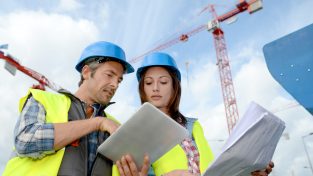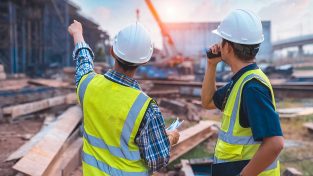Delivering clean water and energy. Building iconic skyscrapers. Planning new cities. Restoring damaged environments. Connecting people and economies with roads, bridges, tunnels and transit systems. Designing parks where children play. Helping governments maintain stability and security. Worldwide, AECOM designs, builds, operates and manages projects like these through Design & Consulting Services, Construction Services and Management Services segments.
BK: Delivering clean water and energy. Building iconic skyscrapers. Planning new cities. Restoring damaged environments. Connecting people and economies with roads, bridges, tunnels, and transit systems. Designing parks where children play. Helping governments maintain stability and security. Worldwide, AECOM designs, builds, operates, and manages projects like these through design and consulting services, construction services, and management services segments.
Welcome to HxGN Radio. My name is Brian. Joining me today is Sam Dougherty, associate vice president of Data Capture and Analysis Global Lead trends at AECOM. He’ll be discussing the trends, challenges, and opportunities in the construction industry and how reality capture and digital transformation, data collection, and analysis are helping to solve the world’s most complex infrastructures challenges. Sam, thanks for joining us today. Tell us a little bit about your role and how you are leading the digital transformation at AECOM.
SD: Yeah, thank you very much. I’m happy to be here. As you mentioned, I’m the associate vice president and involved with the technical practice group of AECOM’s land surveyors. I am also part of the digital transformation. AECOM’s digital transformation initiative covers four areas, digital engineering, modern construction techniques, autonomous, and data collection and analysis. I actually am the global leader for the data capture and analysis segment of that, which basically covers LiDAR, covers UAS, covers asset management, basically anything that has to do with intelligent modeling.
BK: What are some of the challenges and trends that you’re seeing right now in the construction industry?
SD: There’s a lot of different challenges. The main challenge that we see is just adoption, adoption of the practice. Construction obviously started out with a sledgehammer and a lock level and has moved all the way up to the digital age, where it’s at now, and you’ve got a lot of BIM implementation involved with it. The biggest challenge that we find in the adoption of reality capture is just trying to overcome the perception of cost and the negativity related to those perceived notions. The beautiful thing is that companies like Hexagon or Leica Geosystems have created products that allow us to come in there and capture things much more efficiently and cut down on the initial cost up front and present massive savings towards the back end of the project for the owner.
BK: Good, good. Very important things, obviously.
SD: Exactly. Some of the trends that we’re seeing right now are, like I said, the BIM implementation. Recently, the government of the UK has basically mandated that BIM has to be a part of any building six stories and above. That’s important for reality capture because ultimately at that point in time, in order for the owner to have a guarantee on what they are being handed over from the contractor, the ability to go through, utilize reality capture, laser scanning, photogrammetry, whatever process that you use, and deliver that in a timely manner as an actual record of what was built — that’s really important.
Another one of the trends that we’re running across on a regular basis is the digital twin. AECOM works closely with a company called Willow, who creates, basically, digital twins. We’re also seeing rapidly growing interest from the owners of buildings and infrastructure to use digital twin technology to streamline the way that they operate their portfolio. We’ve partnered with Willow, whose digital twin platform combines 3D BIM and point cloud data with asset data like O&M manuals and asset registers, as well as live, real-time data from systems like BMs, so that you can search Willow for a piece of equipment in the building, like a VAV box, see it highlighted in the point cloud model, and scroll through the data for the manufacturer model, serial number, O&M manuals, as well as data like airflow, damper position, and reheat temperature. We’re also seeing another trend that we’re running across right now is more efficient workflow modeling. We go, we utilize the Leica reality capture techniques—your RTC360s, your P-Series laser scanners, your Pegasus:Backpacks—go in and find a way to bridge that gap, the gap between reality capture and delivery, whatever that delivery may be, be it a Revit model, back to the contractor, then it’s back to the owner, be it going into Navisworks and then a Maximo-type program for asset management. We’re constantly searching and using companies like Pointfuse, who is partnered with Leica in one of their product deliveries. Pointfuse goes through and basically creates a mesh model of the point cloud, enhancing the capabilities for intelligent modeling. Therefore, you can basically scan it, register it, process a mesh file, and classify it and send it into Revit in a fraction of the time that you typically would. Those are two of the larger trends that we’re seeing right now.
BK: Nice. Good, good. What opportunities has reality capture opened across key markets that you serve?
SD: Well, it’s opened a lot of opportunities. As you mentioned earlier, AECOM, we aim to DBFO—design, build, finance, and operate. Obviously, reality capture doesn’t have a whole lot to do with financing, but the design portion of it, the build portion of it, and the operating portion of it are really important. And the ability to rapidly capture that reality at any time, it’s a signature of time, helps in all those aspects. The reality capture is also a part of every arm of AECOM—transportation, water, environment, power, buildings and places, construction services, management services. They all have needs for this. Our agreement and our process with Leica has enabled us to fulfill those needs within a company that’s got 87,000 employees, including 46,000 employees in the United States. So, the demand is heavy. We rely on Leica to fulfill that demand, and they’ve come through well.
BK: That’s great. Now, speaking of that, what Hexagon solutions are you relying on, and how is it helping you to make your work more productive, and, of course, providing quality deliverables?
SD: We are using pretty much the entire survey gamut, if you will. We run the gamut, everything from the robotic total stations to the total stations with laser scanners on top of it, GPS, the P-Series scanners, the RTC360 scanners, the Pegasus scanners, the UAS solution that they have, ground penetrating radar solution that they have. We use all of them because when you have a company like ours, where it’s a turnkey service and we need to be able to capture every element of that design or element of that construction process that’s incorporated with it, we leverage our relationship with Leica to get us to that point.
BK: Good. Okay, well you mentioned the RTC360. Tell me what projects that you’ve used that in, and how has it helped you to improve and add value to your projects as well?
SD: We’ve utilized the RTC360 scanner on about 30 million square feet of buildings between projects for the Navy, projects for the Army, projects for major transportation carriers, freight rail, transit rail, highway, bridge, everybody. A lot of it has been for construction documentation, facility management, asset management, space management, and occupancy. We have been using the thing nonstop.
BK: That’s great.
SD: Yeah. We’ve done the 30 million plus, and we have another 45 million on the books to continue to scan.
BK: Wow. So it’s working well.
SD: It’s working quite well.
BK: That is great. What’s the value that reality capture has brought to your projects, then? And list some examples, please.
SD: Yeah, absolutely. The confidence that we have in Leica and the product that they provide, as well as the training that their individuals give our technicians in the field, has created a tremendous value. Number one, I sleep really well at night. The reason I get to sleep well at night is because I know that my people are informed. My people were trained. They know how to go out and do what they need to do. I also know that if they have a problem that they can get hold of their technician or their salesperson or the correct support to fix that problem. So, there’s that whole portion of it. That’s a pick-up for AECOM. That’s a great piece, that confidence piece.
Then, the fact is, that when you go through and utilize a reality capture technique that we have that Leica’s created, in a lot of areas you are 7 to 10 times faster than the traditional tape and DISTO methodology. For instance, we could go through an MEP space that’s 45,000 square feet in a day versus tape and DISTO, which might take three weeks for several people, and then they get back to the office and realize it’s wrong and they got to go back. We can probably get in and out of there in a day or two and be done with it.
BK: That’s incredible. That’s great to hear. Well, you’ve answered a lot of great solutions. It’s helped you out, which is wonderful, but there are a lot of geospatial technology providers out there. So why did you decide to trust and invest in Hexagon?
SD: Well, Leica has this saying, when it has to be right—and I like that, too, because I have to be right—
BK: And you have to sleep at night.
SD: I have to sleep at night. No, in all seriousness, they’ve been great to me. Their service—their equipment is one thing. It’s great equipment. And you’re right; there’s technology providers everywhere. You put the right person behind the right piece of equipment, and you can make it sing. But the people within the group, the people that help you, the people that facilitate the deals, the people that facilitate and train your individuals, the ones that pick up the phone at 2:00 in the morning, because we’re on a railroad in the middle of nowhere, that’s the reason why we came and stayed, and continue to stay, and will continue to stay. The fact that they put out great product is just icing on the cake.
BK: Yeah, yeah. Interesting. You know, usually people say it the other way around. The product’s the most important thing, and then the service is great, but I really appreciate what you’re saying there. I think it’s really important, and it does have a huge factor in your experience being exactly what it needs to be and making sure that solutions are right for your company. Sam, thanks so much. Appreciate your time. Thanks for the information.
SD: Thank you very much. I appreciate it.
BK: For more information on today’s topic, please go over to leica-geosystems.com and aecom.com. And, of course, to learn even more and listen to additional episodes, please head over to hxgnspotlight.com. Thank you very much for joining us here on HxGN Radio.
















